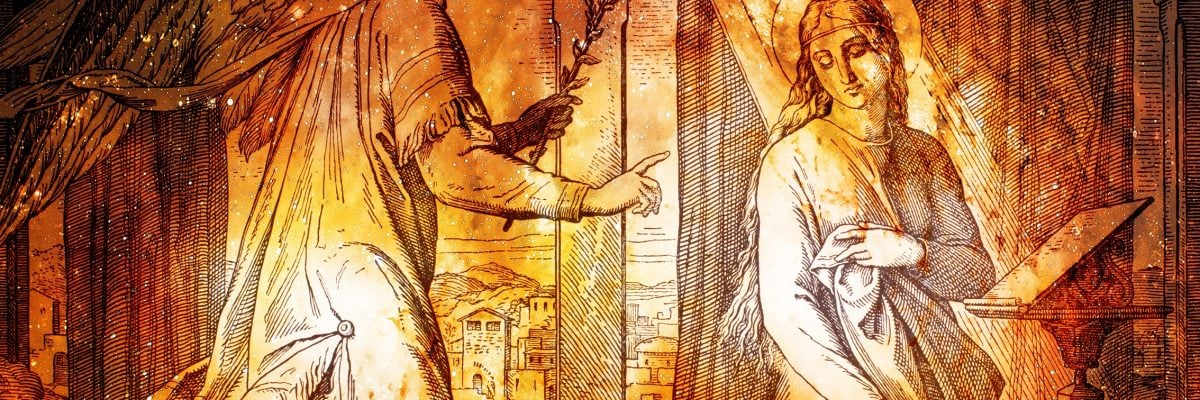
Homily for the Fourth Sunday of Advent, B Cycle
The angel Gabriel was sent from God
to a town of Galilee called Nazareth,
to a virgin betrothed to a man named Joseph,
of the house of David,
and the virgin’s name was Mary.
And coming to her, he said,
“Hail, full of grace! The Lord is with you.”
But she was greatly troubled at what was said
and pondered what sort of greeting this might be.
Then the angel said to her,
“Do not be afraid, Mary,
for you have found favor with God.“Behold, you will conceive in your womb and bear a son,
and you shall name him Jesus.
He will be great and will be called Son of the Most High,
and the Lord God will give him the throne of David his father,
and he will rule over the house of Jacob forever,
and of his kingdom there will be no end.”
But Mary said to the angel,
“How can this be,
since I have no relations with a man?”
And the angel said to her in reply,
“The Holy Spirit will come upon you,
and the power of the Most High will overshadow you.
Therefore the child to be born
will be called holy, the Son of God.
And behold, Elizabeth, your relative,
has also conceived a son in her old age,
and this is the sixth month for her who was called barren;
for nothing will be impossible for God.”
Mary said, “Behold, I am the handmaid of the Lord.
May it be done to me according to your word.”
Then the angel departed from her.
–Luke 1:26-38
Nazareth. It’s a place, a town. It’s still there after thousands of years. People live there and try to survive under very difficult political and social conditions. There are the secular Israelis who live in the new town above the old, and there are the Muslim Palestinians who are citizens of Israel, and then there are the remnant of the once numerous Christian population who have not left under stress from the former two groups. This year, as in many recent Christmases, the Christians of Nazareth have a challenging feast to celebrate.
It was in this town that the Most Holy Trinity revealed the mystery of the Incarnation of the eternal Son of God of the Virgin Mary by the overshadowing of the Holy Spirit. In a certain sense, this town is more graced and more glorious than Jerusalem or Bethlehem—or Rome, or Lourdes, or Fatima—because not only did God and the mother of God come there, but this is the place where God became man, where the divine maternity occurred, where heaven most perfectly and mysteriously joined with earth. As it says over the altar in the house of Mary at the shrine today “Here the Word was made flesh.”
But what was the occasion or circumstance of so infinitely overwhelming a mystery as God’s assuming to himself a human nature, body and soul? For this we can look at the Gospel according to St. Luke for the essentials. That is the text we hear proclaimed today. But if we want to know the concrete circumstances of the event of the Annunciation described in today’s Gospel, we have to look at the Gospel of James.
Now this Gospel is not precisely revealed or part of the Bible approved by the Church, but it is the oldest and most widely read account of the conception and birth of the Savior. Its details have entered into Christian iconography and liturgical poetry and pilgrimage.
According to this account, well borne out by the modern city of Nazareth, the Holy Virgin was drawing water at the town well when the angel of God spoke to her without being seen. Then she went home, and as she was spinning wool yarn of purple for use in the holy temple in Jerusalem, the angel Gabriel appeared to her.
There are two things that are helpful to us today in this account. One is that God reveals himself to us first of all by hearing. That is, we need to listen to the word of God first before we can claim any right to have a deeper understanding. Many people today do not even try to listen to God’s word before giving their opinion or evaluating it. The sincere and humble soul, on the other hand, is always eager to hear the word and to consider it prayerfully before acting.
Then, of course, God can reveal himself by showing something to our sight. Sight is the most noble and most informative of our senses, so it is to be expected that God will give us something for our sight. What do we see? Our Lady saw an angel in human form who swiftly “departed from her.” We, on the other hand, must not presume on so lofty a vision. Rather, we should trust the Lord who says, “Who sees you sees me.” Our neighbor is the revelation of the Lord to us. Our neighbor tells us what the Lord needs from us: love, nourishment, rest, instruction, correction, encouragement, prayer, warmth. This was what Our Lady was doing at her annunciation, making yarn, accomplishing something for the edification of her fellow Jews.
There is no doubt that the Archangel Gabriel is a lesser being than the Blessed Mother. He greeted her with great respect as to a superior. We would do well to treat everyone as better than we are, as the objects of our humble service. If majestic angels can do this to those who are by nature lower than them, surely we can do it to those who are, like us, just “a little less than the angels.” We will see the Lord clearly and we will see the messengers of the Lord if we give ourselves before Christmas to the service of our neighbors.
This is the gift we can give the Lord this Christmas.



